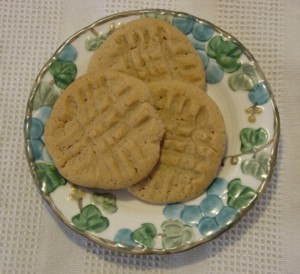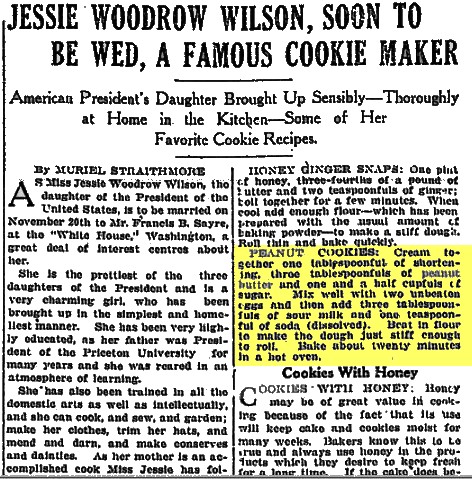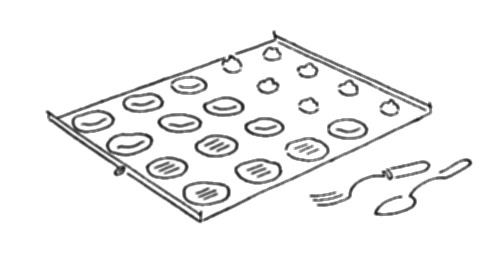

Peanut Butter Cookies
In 1939 The New England Yankee Cook Book, An Anthology of Incomparable Recipes from the Six New England States contained a recipe for “Peanut Butter Cookies”. It was sent in by Mrs. Myron Duefrene of Conimicut, Rhode Island. By then Peanut Butter cookies recipes had been published in various publications in New England since 1917. However, they were adopted into the New England culture they did not originate here.
History
The New England Kitchen Magazine (Vol. 3 No. 4, July 1895, pp 184-185) printed an article titled “An American Delicacy”. It gave a short history of the early use of peanuts and popular uses, but peanut butter was not mentioned. The idea of nut butter, peanut butter being one of the various nuts used to make nut butter had emerged about ten years earlier but was not yet publicly available. Nut butter was used in commercial candy making. What was found in the article was a recipe that was the precursor of the Peanut Butter Cookie. The recipe has one tablespoon of butter and no other shortening. It said to “pound or chop one cupful of peanuts”. The low fat quantity suggests the chopped peanuts made up the rest of the shortening. Early confirmed peanut butter cookies used one tablespoon shortening, lard or butter and 3 tablespoons of peanut butter. The rest of the ingredients listed were half cup sugar, one egg, two tablespoons milk, one cup flour and one teaspoon salt. The ingredient list with the exception of a higher amount of peanuts is similar to the early peanut cookies which used peanut butter. The article listed a U.S. Department of Agriculture pamphlet Farmers Bulletin, No. 25 and Miss Juliet Corson as two early contributors to uses of peanuts. So it is unknown who developed the “Peanut Cookies” recipe listed in the New England Kitchen Magazine article.
An article in Popular Science News in 1897 under “Recent Inventions” said peanut butter could be used as a shortening. It could replace butter and lard in recipes. According to Wikipedia Peanut Butter entry, Marcellus Gilmore Edson of Montreal, Quebec, Canada in 1884 invented a new process for milling roasted peanuts. He was using grist mill type grinding stones that were set up to produce flour. In his account to the United States Patent Office he made a distinction between grinding methods indicating the “old” cold grinding method produced “peanut flour” verses his new hot grinding method produced “flavoring-paste”, grinding peanuts into “a fluid or semi-fluid state.”. As the fluid state cooled it became the “consistency like that of butter, lard, or ointment.” Edson used his peanut paste in making peanut candies. Edson’s taking out a patent on his process seems to be a way to license or market it to commercial candy makers. In 1895 and 1897, J.H. Kellogg of breakfast cereal fame and his brother W.K. Kellogg invented their own process for making a ‘pasty adhesive substance’ that Kellogg called ‘nut-butter’. Kellogg appears to have attempted to capitalize on the popular new invention of peanut butter for commercial sales. In the 1890’s Dr. Ambrose Straub of St. Louis, Missouri, modified the common food grinder to make it into a peanut grinding machine that made peanut butter. It was patented in 1903. Dr. Ambrose also saw a commercial aspect in that he saw peanut butter as a food product for “providing toothless elderly with protein.”
Mrs. Rorer’s New Cook Book (1902, Philadelphia, Pennsylvania) published the first cookie recipe with peanut butter. She had a chapter devoted to “Nuts” in which she explained how to process them. Under it was “Peanut Butter”, “Peanut Meal” and “Peanut Wafers” (page 535). For both meal and butter peanuts were roasted and then put through a grinder. One grinder setting produced an oily mixture called peanut butter and another grinder setting produced a meal (i.e. coarse flour similar to corn meal). Although Mrs. Rorer does not state whether the peanuts are hot or cold when processed she does make indications. For peanut butter she said to “grind at once” indicating the peanuts were still warm. This follows what M.G. Edson had figured out in his “hot process” method. For peanut meal, she recommended roasting only as long as necessary to loosen the skins, indicating a cooler peanut temperature than used for peanut butter, plus she does not say to grind at once. This indicates that the peanuts were cool when they were ground up thus producing dry meal (flour like substance). She recommended packing both the peanut butter and peanut meal in jars for storage. The “Peanut Wafers” was a recipe for a thin cookie. The recipe listed “a half cup of peanut meal with a half cup of peanut butter”. It used peanut butter for the shortening as no other shortening was listed.
By 1911 peanut butter was being manufactured and sold commercially in jars. The Squirrel Brand Company of Cambridge, Massachusetts ran an advertisement in Chisholm’s White-Mountain Guide-Book selling Salted Nut Meats, Almonds, Pecans, Peanuts, Stuffed Dates, Nut Candies and Peanut Butter. The nuts were sold in “5-Cent Packages For Sale on Trains”. The company had found a way to market nuts to tourists as snacks.
In the March 16, 1913 issue of the Reading Eagle (Pennsylvania) was an article, “Some of Mrs. Wilson Favorite Recipes: The President’s Wife Gives Hints on Cooking” It was a list of cookie recipes one was “Peanut Cookies”. The recipe called for peanut butter and was a slightly richer recipe than Mrs. Rorer’s Peanut Wafers. This was followed in the November 15, 1913 issue of The Saskatoon Phoenix (Canada) with an article titled, “Jessie Woodrow Wilson, Soon To Be Wed, a Famous Cookie Maker”. Included in the article was the same list of cookie recipes that was listed under Mrs. Wilson’s article, wife of the president. The two newspapers used the high status of President Wilson’s wife and daughter in publishing their cookie recipes to increase sales. The increased sales and the status of the two women popularized the “Peanut Cookie” which used peanut butter.

These early Peanut Cookies called for “1 tablespoon of shortening, 3 tablespoons of peanut butter”. In it peanut butter was substituted for some of the shortening. This reflects the Popular Science News article that stated peanut butter could be used as a substitute for shortening.
Two years later in 1915, the Larkin Company of Buffalo, New York who produced their own peanut butter, published the Larkin Housewives’ Cook Book (1915). In it was the “Special Peanut Cookies” recipe which used Larkin Peanut Butter. It was sent into the Larkin Company by Mrs. G. W. Parrins, Lyons, N.Y. The Special Peanut Cookies recipe was the same recipe that Mrs. Wilson and Jesse Wilson favored. Likely the recipe had been republished in other newspapers in the region.
The earliest use of the term “peanut butter” in a cookie recipe was found in the Newark Sunday Call of Newark, New Jersey on September 19, 1913. The recipe was titled “Prune Peanut Butter Cookies”. This recipe called for brown sugar instead of white sugar, and a large quantity of fat ½ cup shortening and ¾ cup peanut butter to a ratio of 2 cups flour. Although it used prunes in the recipe it is interesting to note this was the forerunner of the modern Peanut Butter Cookie. It used a high ratio of shortening and peanut butter combined, and brown sugar. Some modern Peanut Butter Cookie recipes still use the same ratio of shortening to peanut butter.
Wikipedia’s Peanut Butter entry stated, “The United States and China are leading exporters of peanut butter.” This is reflected in the 1916 Anglo-Chinese Cookbook compiled and edited by Mrs. R. Calder-Marshall & Mrs. P. L. Bryant, two American named ladies and published in Shanghai, China. The ladies included recipe “57. Peanut-Butter Cookies” which makes it the earliest pure peanut butter cookie recipe with the name. This was a popular cook book as it was printed in the English language and Chinese language. The Peanut Butter Cookies were listed under “American Cookies”.
The following year in 1917 “Query #3803. – Recipe for Cookies made with Peanut Butter” was answered in the Boston Cooking School’s American Cookery magazine (Vol. 21, No. 8, March 1917, p. 636). It was named “Peanut Butter Cookies”. This recipe is a combination of the earlier recipes but it too retained the low quantity of shortening as well as using less shortening to more peanut butter.
In 1918, three war time Peanut Butter Cookies recipes were published. The Farm Journal published in Philadelphia, Pennsylvania had an article “Patriotic Women Will Use these New Recipes” (Vo. 42, No. 7, July 1918, p 26). “Peanut Butter Cookies (sugarless), require six tablespoons of fat, one fourth cupful [4 tablespoons] peanut butter, …” In this recipe there is more fat than peanut butter. The recipe came from a farm journal, farms had access to butter and lard that the general public did not have, hence the increase instead of decrease in fat as is seen in the other war time recipes. It brought the concept of a higher ratio of shortening / peanut butter seen in an earlier recipe to more readers. The other two war time recipes utilized peanut butter much more heavily for the shortening. Peanut butter apparently was more readily available than other shortenings during the World War I.
The quantity of shortening to peanut butter was not the only issue being worked out. How to shape the cookie was also of importance. In the August 27, 1917 Reading Eagle a lady contributed three different peanut butter cookie recipes. “Peanut Butter Cookies – make a soft dough and pat rather than roll out.” “Peanut Butter Drop Cookies – Drop in small spoonfuls on greased baking sheet”. “Peanut Butter Oatmeal Cookies – shape into balls”. In the July 25, 1917 Robinson Constitution it read, “This Recipe Sounds Good” “Peanut Butter Cookies – Chill, roll thin, shape” The Newburgh Daily dated April 22, 1918 had “Peanut Butter Cookies – Shape the cookies with a small cutter”. Five recipes each with a different way to handle and shape the cookies. The “drop” and “ball” versions are thick lumps of raw cookie dough. Neither of the recipes said to flatten the lumps, whereas the other recipes called to flatten the dough by rolling or patting.
Post World War I changes were occurring in the Peanut Butter Cookie. In the Schenectady [NY] Gazette – July 1, 1932 there was a recipe for Peanut Butter Cookies. The recipe said to “make balls … press each one down with a fork, first one way and then the other, so they look like squares on waffles.” It listed one cup shortening and one cup peanut butter, and called for half brown sugar and half white granulated sugar. In this recipe there are equal quantities of shortening and peanut butter. This made for a better textured cookie. It also used equal quantities of brown sugar and white sugar. In most early recipes white granulated sugar was used with some exceptions one recipe used brown sugar and a few war time recipes used molasses. Someone figured out the taste of molasses in brown sugar combined with white sugar made a pleasing flavor combination. The other change was the “fork” used to flatten the cookie. It left an imprinted pattern on the cookie. Where and when did the use of the fork start occurring?
Back in the year 1916 a recipe called “Spiced Oat Cookies” in the Handy Household Hints and Recipes (Louisville, KY) were flattened with a fork. “Drop in small quantities, from the tip of a spoon, on a greased cooky pan. With a fork flatten each cooky slightly.” Two years later in 1918 Wheatless and Meatless Menus and Recipes (Boston, MA) is a recipe for “Oatmeal Crisps”. “With a fork dipped in cold water flatten out into circular shape no thicker than a piece of rolled oats.” The fork allowed the cook to flatten the cookie wafer thin. Ironically, the Oatmeal Crisps were on the same page (16) as “Peanut Butter Cookies” which read “Chill, roll thin, cut in fancy shapes”. The Battle Creek Cook Book: a collection of well tested recipes from the First Congregational Church (Battle Creek, Michigan) listed a recipe for “Brown Sugar Cookies” which said to “pinch off dough the size of a walnut and roll in the hands [a ball]. Put in the pan and flatten with a broad fork.”
Another cookbook The Bakers Business Booster (1922, Boston, MA) had a recipe for “Mailander Cookies” which read, “after being washed over with [egg] yolks, and marked with the ends of a fork crosswise.” Washing the cookie with egg yolk gave it a nicer finish. Pressing it with the tips of a fork crosswise formed a directional pattern. The two extra steps made a plain cookie look fancy. This is in line with “cut in fancy shapes” as the Peanut Butter Cookies recipe called for. The 1947 edition of The Boston Cooking-School Cook Book had a descriptive illustration on page 714 with the following explanation, “Arrange by spoonfuls on buttered cooky sheet, press flat with floured spoon, and mark with floured fork.” The marks were a single set of parallel lines.This shows the fork was sometimes used to make decorative marks on cookies. This pattern is different from the “waffle pattern” in the 1932 recipe published in the Schenectady, New York newspaper. The New York recipe is the earliest known version to use the waffle pattern which is known today as the “criss-cross” pattern.

Illustration from 1947 edition of the Boston Cooking-School Cook Book
showing how the spoon and fork are used to form the cookies
According to the Wikipedia entry on Peanut Butter Cookies, the 1933 edition of the Pillsbury’s Balanced Recipes instructed cooks to use a fork to press the cookie flat. The use of a fork to flatten the Peanut Butter Cookie was likely popularized through Pillisbury’s cook book. But the entry does not state which pattern was used 1) parallel lines or 2) criss-cross. The 1938 edition of The Settlement Cook Book used the name, “Criss-Cross Peanut Butter Cookies” (page 480) forever associating the criss-cross pattern with the Peanut Butter Cookie. The Settlement Cook Book went through many editions and was as popular in the Mid-West as the Boston Cooking School Cook Book was in the northeast.
The fork was originally used to flatten a cookie very thin in lieu of rolling the dough. In time, the fork’s purpose changed. Cookies were often served at ladies functions where presentation was as important as taste. The imprint that the fork left on the cookie made a desirable decorative pattern. Sometime in the 1930’s the criss-cross pattern became the hallmark of the Peanut Butter Cookie.
The changes that came about in the 1930’s perfected the Peanut Butter cookie. But not every cook book author followed suit immediately. The Boston Cooking School Cook Book’s 1936 edition listed “Peanut Butter Cookies” under “Sugar Cookies”. The cook book used a simple way of converting a basic sugar cookie recipe into numerous different types of cookies. It said to substitute peanut butter for the butter. The modern “Peanut Butter Cookies” recipe appears eleven years later in the 1947 edition as a distinct cookie complete with an illustration on how to decorate it with a fork. Today (2011) Peanut Butter Cookies are still made the same way: half white granulated sugar and half brown sugar, equal quantities of shortening and peanut butter and pressed with fork to form a criss-cross pattern.
“Special Peanut Cookies” from Larkin Housewives’ Cook Book by Mrs. G. W. Parrins, Lyons, NY (1915)
3 tablespoons Larkin Peanut Butter
1 tablespoon lard
1½ cups granulated sugar
2 eggs
2½ cups flour
1 teaspoon baking soda dissolved in 3 tablespoons thick sour milk
1 teaspoon Larkin Vanilla Extract
Mix, roll, cut and bake
“Peanut Butter Cookies” (1930’s up to present [2011])
½ cup butter (softened) or shortening
½ cup white sugar (granulated)
½ cup brown sugar
1 egg
½ teaspoon vanilla
½ cup peanut butter, any style
1¼ cups flour
1 teaspoon baking soda
Cream together: butter, sugars, egg, and vanilla; mix in peanut butter.
Sift dry ingredients and mix into creamed mixture
Drop by rounded teaspoonfuls on to ungreased cookie sheet
Press with fork to make criss-cross pattern
Bake 350 degrees for 10 minutes
Makes about 3 dozen
